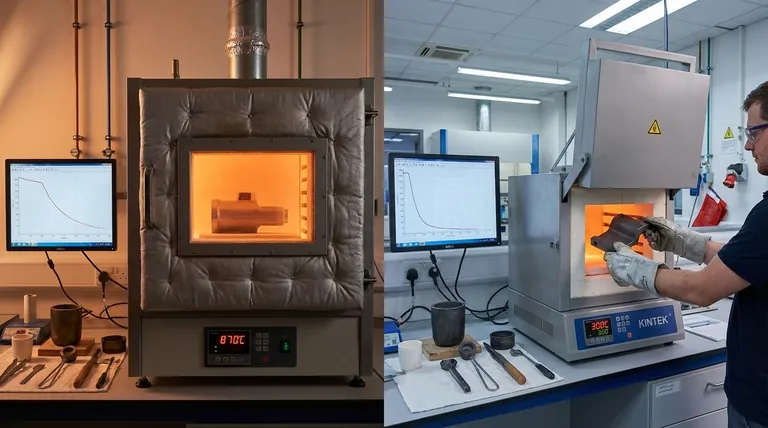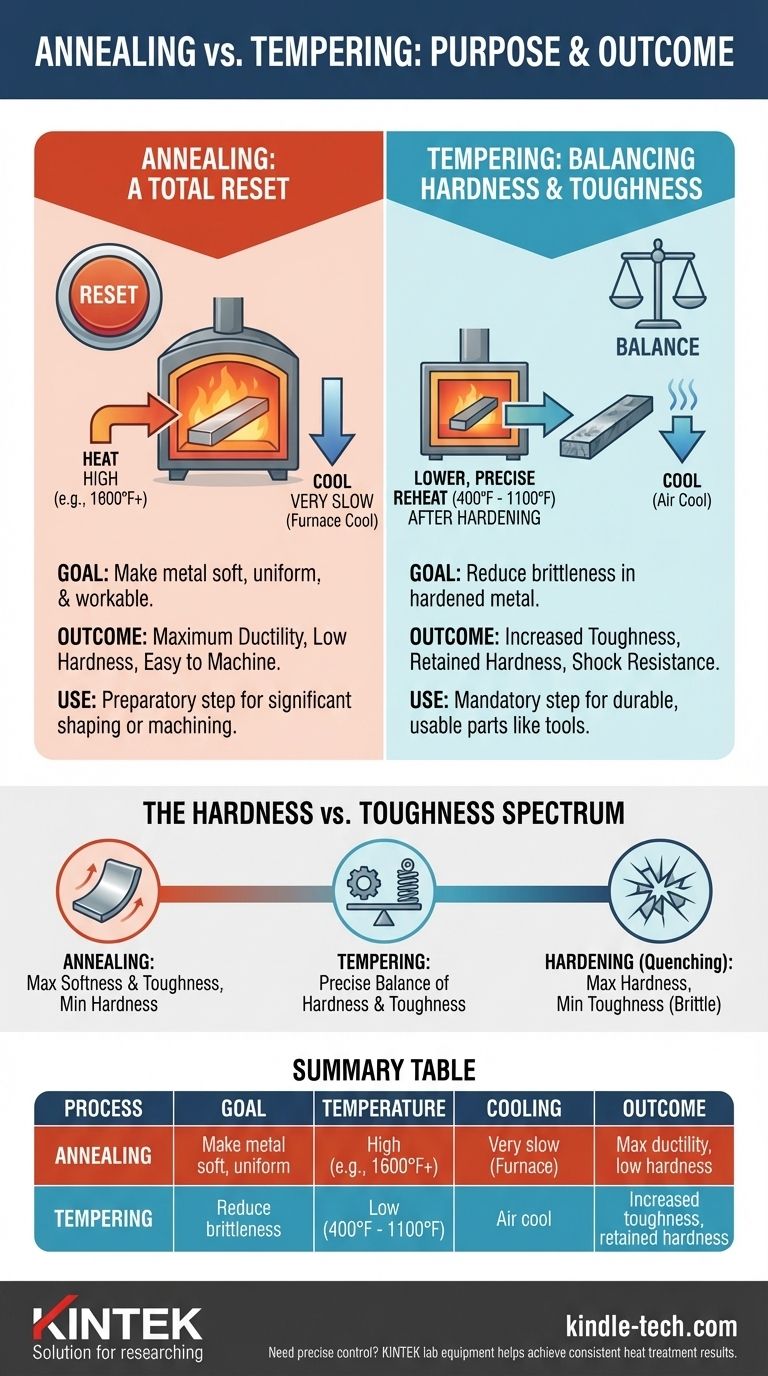At its core, the difference is one of purpose and outcome. Annealing is a heat treatment process designed to make a metal as soft, uniform, and workable as possible by heating it to a high temperature and cooling it very slowly. Tempering, in contrast, is a lower-temperature process performed after a metal has already been hardened to reduce its brittleness and increase its toughness.
While both are heat treatment processes, they serve opposite functions. Annealing is a "reset button" that maximizes softness and relieves internal stress. Tempering is a fine-tuning step that trades a small amount of hardness for a significant increase in toughness in an already hardened part.

The Goal of Annealing: A Total Reset
Annealing is used to put a metal into its softest, most stable, and most uniform state. It is a preparatory step, not a final finishing process for parts that require hardness.
The Process: Heat High and Cool Slow
To anneal a metal like steel, it is heated well above its critical temperature—often to 1600°F (870°C) or higher. It is held at this temperature long enough for its internal crystalline structure (grains) to reform completely.
The most critical step is the extremely slow cooling. The metal is often left to cool down over many hours inside the insulating furnace after it has been turned off. This slow cool allows large, uniform, and stress-free grains to form.
The Outcome: Maximum Ductility and Machinability
An annealed part has minimal internal stress, low hardness, and high ductility. This makes the metal very easy to bend, form, or machine. It erases the effects of previous work hardening or improper heat treatments.
When to Use Annealing
You anneal a workpiece when you need to perform significant shaping or machining. It is also used to prepare a piece of steel with an unknown or inconsistent history for a new, controlled hardening and tempering cycle.
The Goal of Tempering: Balancing Hardness and Toughness
Tempering is never a standalone process. It is the mandatory second step that always follows a hardening procedure (heating and then rapidly quenching in oil or water).
The Prerequisite: Hardening
Hardening makes steel extremely hard but also dangerously brittle, like glass. A hardened but untempered blade or tool would likely shatter upon its first use. Tempering corrects this brittleness.
The Process: A Lower, Precise Reheat
The hardened part is cleaned and then gently reheated to a much lower, very specific temperature—typically between 400°F and 1100°F (205°C and 595°C). This temperature is always below the metal's critical point.
The part is held at this temperature for a set time to allow some of the trapped stress and brittle internal structures to relax and reform. It is then typically allowed to cool in still air. The exact temperature used determines the final balance of hardness and toughness.
The Outcome: Reduced Brittleness, Retained Hardness
Tempering makes the steel significantly tougher and more resistant to shock and impact. While it does slightly reduce the peak hardness achieved during quenching, the trade-off is essential for creating a durable, usable part like a knife, axe, or spring.
Understanding the Trade-offs
Choosing between these processes is not a matter of preference; it is dictated by the desired mechanical properties of the final part.
The Hardness vs. Toughness Spectrum
Think of a material's properties on a spectrum. Annealing pushes the metal all the way to one end: maximum softness and toughness, but minimum hardness. Hardening (quenching) pushes it to the opposite end: maximum hardness, but minimum toughness (maximum brittleness).
Tempering is the art of precisely navigating the space between those two extremes to find the ideal balance for a specific application.
A Common Point of Confusion: Stress Relief
Both processes relieve internal stress, but for different reasons. Annealing performs a full-scale stress relief by completely recrystallizing the metal's grain structure, erasing its history.
Tempering performs a more limited stress relief specifically to reduce the extreme brittleness caused by hardening, without sacrificing too much of that newfound hardness.
Making the Right Choice for Your Material
Your choice is determined entirely by what you need the metal to do next.
- If your primary focus is to make metal as soft as possible for machining or forming: Your only choice is to perform a full anneal.
- If your primary focus is to make a hardened part usable and resistant to shattering: You must temper the part to increase its toughness.
- If you are starting with a piece of scrap steel with an unknown history: Anneal it first to create a uniform, predictable baseline before you begin any hardening and tempering cycle.
Understanding this distinction allows you to precisely control a material's final properties, moving from guesswork to intentional engineering.
Summary Table:
| Process | Goal | Temperature | Cooling | Outcome |
|---|---|---|---|---|
| Annealing | Make metal soft, uniform, and workable | High (e.g., 1600°F+) | Very slow (furnace cool) | Maximum ductility, low hardness, easy to machine |
| Tempering | Reduce brittleness in hardened metal | Low (400°F - 1100°F) | Air cool | Increased toughness, retained hardness, shock resistance |
Need precise control over your material's properties? KINTEK specializes in lab equipment and consumables for all your heat treatment and materials testing needs. Whether you're annealing for machinability or tempering for toughness, our solutions help you achieve consistent, reliable results. Contact our experts today to discuss how we can support your laboratory's success!
Visual Guide

Related Products
- Vacuum Heat Treat Furnace and Levitation Induction Melting Furnace
- Vacuum Heat Treat Sintering Brazing Furnace
- Molybdenum Vacuum Heat Treat Furnace
- Vacuum Heat Treat and Molybdenum Wire Sintering Furnace for Vacuum Sintering
- Vertical Laboratory Quartz Tube Furnace Tubular Furnace
People Also Ask
- Why do you heat treat in a vacuum? Achieve Perfect Surface Finish and Material Integrity
- What is low temperature vacuum? A Guide to Precision, Oxide-Free Thermal Processing
- How does heat treatment process work? Tailor Material Properties for Your Application
- What is the process of vacuum quenching? Achieve Superior Hardness with a Pristine Surface Finish
- What are the four types of heat treating processes? Master Annealing, Normalizing, Hardening, and Tempering



















